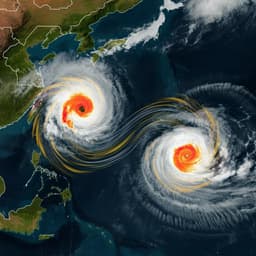
Earth Sciences
Warming-induced contraction of tropical convection delays and reduces tropical cyclone formation
G. Zhang
Explore how climate models reveal surprising insights into future tropical cyclone activity, as research by Gan Zhang uncovers the impact of warming-induced contraction of tropical convection on TC formation and peak-season activity.
Playback language: English
Introduction
The global risk of tropical cyclones (TCs) in the future heavily depends on changes in TC frequency, a factor significantly influenced by anthropogenic warming. Warming leads to rising sea levels, increased extreme precipitation, and stronger intense storms. Despite extensive research, projections of global TC frequency remain uncertain, with models showing conflicting results – some predicting a decrease, while others, like statistical-dynamical downscaling models, suggest an increase. This discrepancy stems from varying model parameters, input variables, and the lack of a comprehensive theoretical framework to explain the simulated changes and validate model assumptions.
Existing theories primarily focus on atmospheric convection's role in TC development. Some emphasize changes in vertical mass flux, suggesting that reduced time-mean upward mass flux or increased upward mass flux per TC hinders genesis. Others highlight the increasing saturation deficit in a warmer troposphere, implying that drying suppresses TC development by slowing convection saturation and enhancing ventilation. A newer perspective links increased TC frequency to ocean warming, which boosts convective activity (including TC-seeding disturbances) and expands the TC-permitting environment's latitudinal range. However, these theories rarely connect, and their links to large-scale climate changes are poorly understood.
Another research area centers on the Hadley circulation, a global-scale circulation with equatorial ascent and subtropical descent. Anthropogenic warming is projected to weaken and poleward expand the Hadley circulation, although natural variability complicates this. This expansion has been qualitatively linked to observed and simulated TC activity changes. The Hadley circulation's configuration depends on tropical convection's location, with equatorial convection hindering and off-equatorial convection favoring TC development. However, past studies have largely neglected the seasonal migration and future changes in tropical convection.
Literature Review
Studies on the impact of climate change on tropical cyclone activity have yielded inconsistent projections regarding changes in frequency. Some global climate models project a decrease in global TC frequency, while others, particularly high-resolution models, suggest an increase due to surface warming generating more seeding convective disturbances. Statistical-dynamical downscaling models have also offered contrasting results, adding to the uncertainty. The lack of a unifying theoretical framework to explain these divergent projections has been identified as a major obstacle in reconciling these conflicting findings. Existing theories often focus on specific aspects of convective processes, such as changes in vertical mass flux, saturation deficit, or ocean warming-induced convective activity, but fail to provide a comprehensive explanation that integrates these different mechanisms and accounts for large-scale climate changes.
Methodology
This study analyzes high-resolution large ensemble climate simulations from the Database for Policy Decision Making for Future Climate Change (d4PDF), utilizing the Meteorological Research Institute-Atmospheric General Circulation Model version 3.2 (MRI-AGCM3.2H) with ~60-km grid spacing. The analysis includes a historical simulation (1951–2010) driven by observed forcings and a future warming simulation (2081–2110) using greenhouse gas forcing corresponding to the CMIP5 RCP8.5 scenario. The warming simulation incorporates SST warming patterns from six CMIP5 models, each scaled to a 4-K warming relative to the preindustrial climate. A 100-member ensemble for the historical simulation was generated by perturbing initial atmospheric conditions and SST, while the future warming simulation comprises 15 members for each warming pattern.
Observational data include the ERA5 reanalysis for tropical convection and the IBTRACS dataset for tropical cyclones, focusing on the period 1981-2010. CMIP6 data from high-resolution models were also used to assess the robustness of the findings. The Intertropical Convergence Zone (ITCZ) latitude was defined using a centroid calculation weighted by convection intensity. TC genesis was defined as the first point of individual TC tracks from the large ensemble simulations and IBTRACS. Analysis of the TC seasonal cycle used histograms of TC genesis time in individual basins, employing 5-day bins (pentads). The Seed Propensity Index (SPI) and large-scale environmental variables (vertical wind shear and mid-tropospheric humidity) were analyzed to explore the link between convection contraction and TC genesis.
Key Findings
The study reveals a robust warming-induced contraction of tropical convection, manifesting as stronger equatorial and weaker off-equatorial convection, particularly evident in the Northern Hemisphere. This contraction is consistent across seasons and highlighted by the delay in the poleward migration of the ITCZ, especially during the early part of the TC season. Analysis of the large ensemble simulations shows a statistically significant decrease in TC genesis frequency associated with this contraction, most pronounced near the ITCZ, particularly during transition months and peak seasons. The warming simulations project shorter and delayed TC seasons, with changes up to a 10% reduction in season length. The suppression of TC activity in the transition seasons is particularly significant and accounts for a large portion (-75% on average) of the projected decrease in overall TC frequency.
Analysis of the seed propensity index (SPI), vertical wind shear, and mid-tropospheric humidity at peak TC seasons reveals that the SPI decreases near the ITCZ in both hemispheres, accompanied by mid-tropospheric drying and increased vertical wind shear. These factors suppress TC development, providing further support for the link between convection contraction and reduced TC frequency. Furthermore, the study demonstrates a correlation between warming-induced changes in equatorial convection and TC frequency, especially in the Northern Hemisphere. While this correlation is less strong in the Southern Hemisphere, a strong link exists between off-equatorial convection and TC frequency changes in this hemisphere.
Discussion
The findings highlight the importance of the warming-induced contraction of tropical convection in explaining the simulated response of TC frequency to anthropogenic warming. The stronger equatorial and weaker off-equatorial convection delay the shift to a TC-favoring atmospheric circulation state, potentially shortening TC seasons and suppressing peak-season activity. The study integrates existing hypotheses about factors influencing TC changes (e.g., weaker mass flux, drying, fewer disturbances) under a unifying framework centered on tropical convection changes. This integration provides a more complete understanding of the complex interplay of factors driving projected changes in TC frequency, improving our understanding of the challenges in projecting future TC risk.
Conclusion
This study demonstrates that the warming-induced contraction of tropical convection, characterized by strengthened equatorial and weakened off-equatorial convection, plays a crucial role in delaying and reducing tropical cyclone formation. This contraction contributes significantly to the shortening of TC seasons and the suppression of peak-season activity. The findings highlight the need for further research focusing on the interactions between equatorial and off-equatorial convection, and the role of various physical mechanisms in shaping the response of TC frequency to climate change. Improved theoretical understanding, coupled with higher-resolution climate models incorporating additional climate processes, will significantly enhance our confidence in predicting future TC risk.
Limitations
The study's conclusions rely on the fidelity of the examined climate models in simulating multi-scale physical processes and their changes due to anthropogenic warming. While observational studies show some signals consistent with the simulated contraction, the observed and modeled changes in TC season length are complex and may be influenced by additional factors like natural variability or other anthropogenic forcings (e.g., aerosols). Furthermore, the analysis focuses primarily on the global-scale changes in TC frequency, and regional variations may not be fully captured. The reliance on the SPI as a proxy for the frequency of rotating convective disturbances also introduces uncertainty, as the definition of TC 'seeds' and their role in TC climatology are still actively debated.
Related Publications
Explore these studies to deepen your understanding of the subject.







